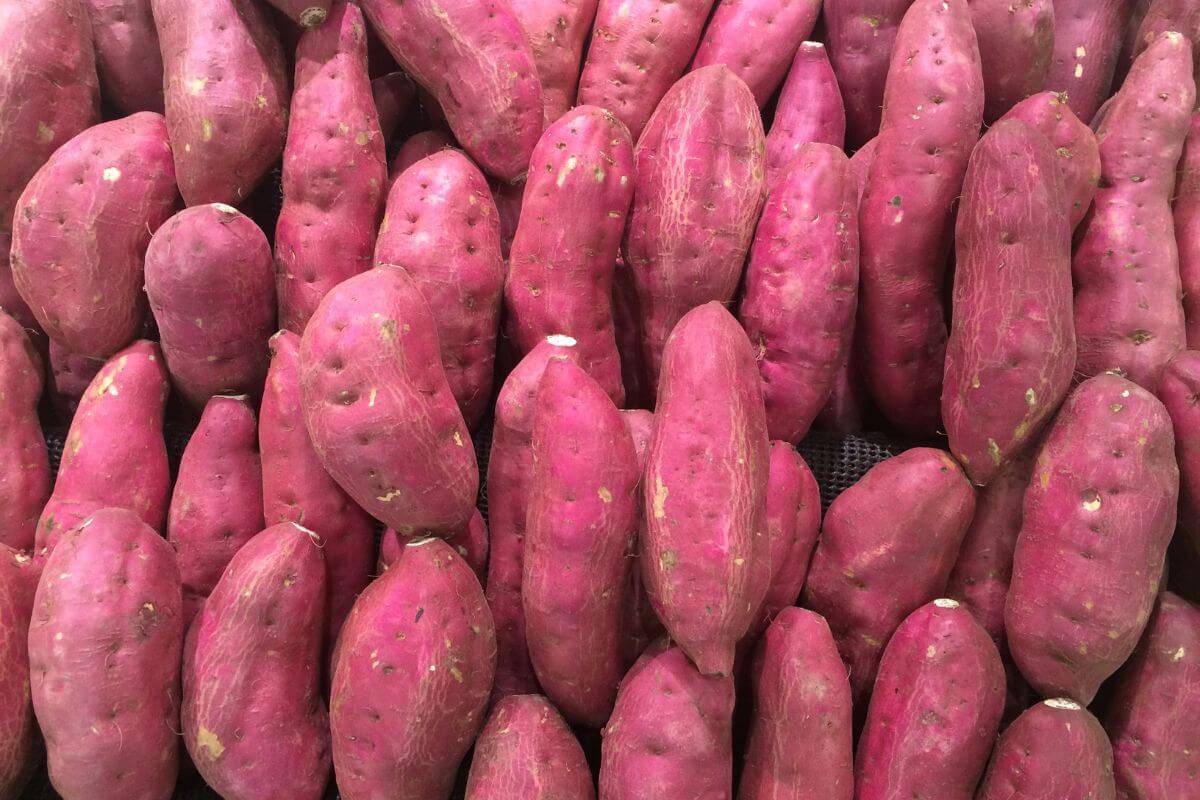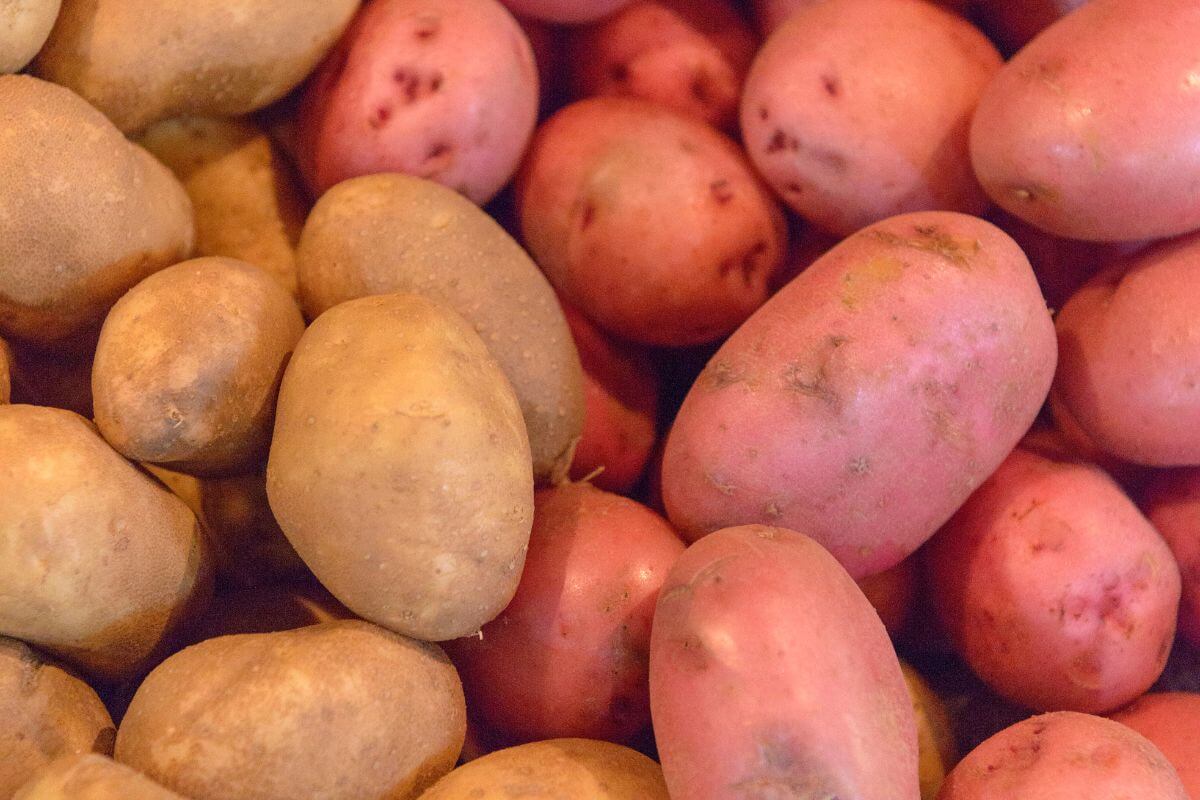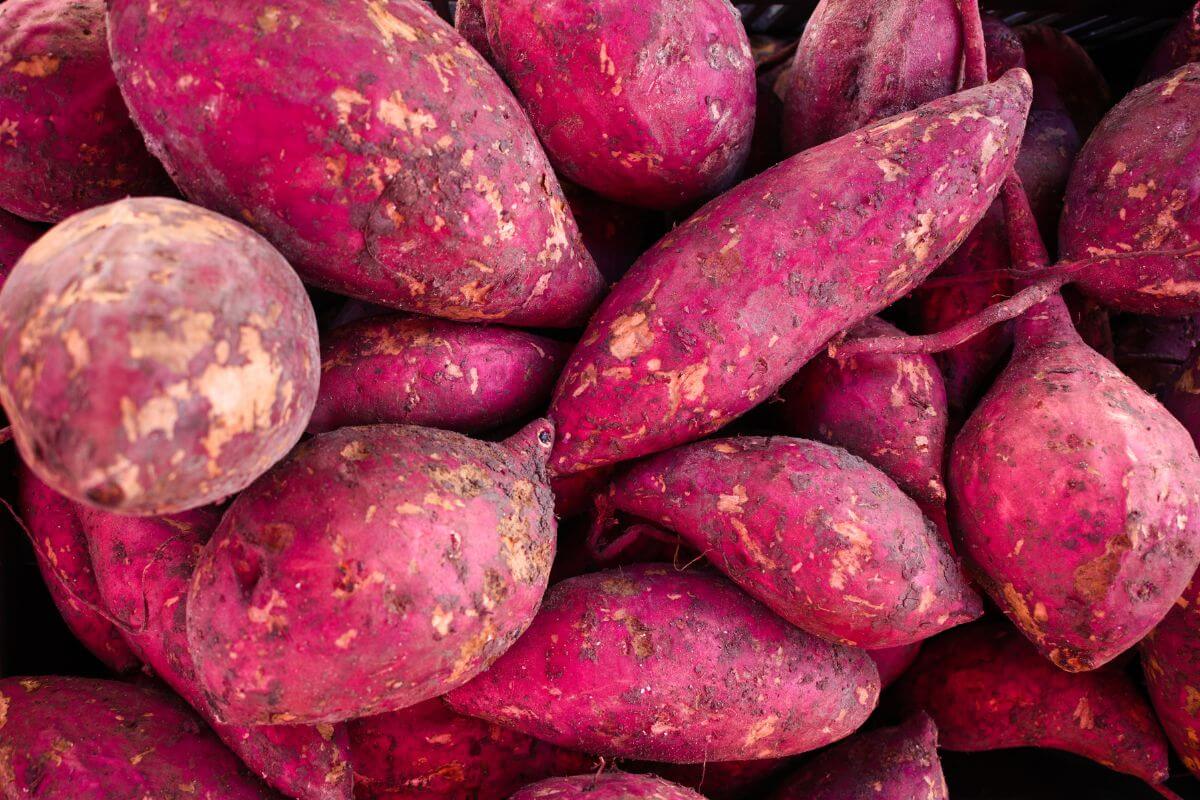Ever wondered if that delicious sweet potato on your plate is a fruit or a vegetable? It’s a question that might surprise you because sweet potatoes are often mistaken for their more common cousin, the regular potato. Despite their sweet taste, sweet potatoes are indeed vegetables, specifically root vegetables.
I’ll dive into the botanical classification of sweet potatoes to understand why they’re not fruits. You’ll learn about their culinary uses and how they differ from regular potatoes and yams. Plus, we’ll explore their nutritional content and health benefits.
Curious about how sweet potatoes stack up against other foods? Keep reading to uncover the fascinating details about this versatile vegetable and discover how it can add flavor and nutrition to your meals.
- Related article: How Can You Tell Apart a Fruit From a Vegetable?
4 Key Takeaways on Is Sweet Potato a Fruit or Vegetable
- Sweet potatoes are vegetables. They grow underground and belong to the Morning Glory family. Unlike fruits, which come from flowers and have seeds, sweet potatoes are tuberous roots. They’re grown for their starchy goodness.
- In the kitchen, you can use sweet potatoes like other veggies. They work in both savory and sweet dishes. You might bake, mash, roast, or toss them into soups and casseroles.
- Nutritionally, sweet potatoes pack a punch. Just one cup of baked sweet potato gives you 769% of your daily vitamin A, 65% of vitamin C, and 21% of fiber. That’s a lot of bang for your buck!
- Don’t confuse sweet potatoes with regular potatoes or yams. They differ in botanical background, nutrition, and taste. Sweet potatoes are sweeter and have more fiber and vitamins.
Is Sweet Potato a Fruit or Vegetable?

Sweet potatoes are root vegetables, not fruits, and we often use them like vegetables in cooking. They’re part of the Morning Glory family and are starchy, making them different from many other vegetables. Let’s break down what that means:
- Culinary Perspective – We use sweet potatoes in many dishes, both savory and sweet. But in cooking, we often think of them as vegetables. You can bake, mash, roast, or add them to soups and casseroles. They’re starchy vegetables because they have more carbs than non-starchy ones, like leafy greens.
- Botanical Classification – Sweet potatoes (Ipomoea batatas) are tuberous roots. They grow underground and belong to the Morning Glory family. This is different from regular potatoes, which are part of the nightshade family. Also, sweet potatoes are not fruits. Fruits come from the flowering part of a plant and have seeds. Sweet potatoes are grown for their starchy roots.
How Are Sweet Potatoes Different From Regular Potatoes?

Sweet potatoes and regular potatoes are both popular in our kitchens, but they’re quite different in many ways. Let’s break down these differences:
| Aspect | Sweet Potatoes | Regular Potatoes |
|---|---|---|
| Botanical Background | Belong to the morning glory family, Convolvulaceae; not related to regular potatoes | Belong to the nightshade family, Solanaceae; a different plant family from sweet potatoes |
| Nutritional Value | High in vitamin A (beta-carotene), denser in calories and carbs, more dietary fiber | High in potassium, lower in calories and carbs, less dietary fiber |
| Taste and Feel | Naturally sweet and nutty flavor; moist, creamy texture when cooked | Mild, earthy flavor; texture can be waxy or starchy depending on the variety |
| Glycemic Index | Often lower glycemic index when boiled, better for blood sugar management | Higher glycemic index, but varies based on cooking method |
| Cooking Uses | Versatile in desserts or sweet dishes; can be baked, boiled, mashed, or fried | Commonly used in savory meals; can be baked, boiled, mashed, or fried |
| Cost and Growing | Tend to be more expensive due to higher demand and less widespread farming | Generally more affordable and widely available |
In short, while they might seem similar, sweet potatoes and regular potatoes are quite different in taste, nutrition, and how we use them in our cooking.
- Read more: Is Potato a Vegetable?
How Are Sweet Potatoes and Yams Different?
Sweet potatoes and yams are not the same, even though many people think they are. Below is a table that showcases their differences:
| Aspect | Sweet Potatoes | Yams |
|---|---|---|
| Botanical Family | Belong to a different family and are roots | True yams are monocots and part of the Dioscoreales order |
| Appearance | Usually rounder and bigger; come in colors like purple and yellow | Mostly white or beige |
| Skin | Thin, smooth skins | Thicker, patchy skins |
| Texture | Stay moist when cooked | Often drier |
| Taste | Sweeter than yams; both are sweet, but sweet potatoes are notably sweeter | Less sweet compared to sweet potatoes |
| Nutritional Content | Packed with vitamins and minerals | Similar nutritional profile, also rich in vitamins and minerals |
| Cooking Uses | Can be cooked similarly to yams; often used interchangeably in recipes | Can be cooked similarly to sweet potatoes; often used interchangeably in recipes |
How to Know When Sweet Potatoes Have Gone Bad

Once harvested, sweet potatoes can last for several weeks before turning bad. They can rot from the inside out though. This means that their appearance will not indicate if the sweet potato has gone bad. You might only know the sweet potato has gone bad when you slice it open.
Outside signs are often very difficult to see, but bad sweet potatoes may have:
- Discoloration
- Holes
- Mold
- Rotten spots
- Shriveling
Inside the sweet potato, white spotting will develop as it rots. The odor emanating from the sweet potato may also be unpleasant. The sweet potato may be soft and squishy when held.
A sweet potato must never be sticky to the touch or feel wet. Their coloring should be consistently brown, orange, or purple throughout the entire potato.
If the sweet potato excretes a white liquid, this is normal and does not mean the potato has gone bad.
How to Store Sweet Potatoes
Your sweet potatoes will last longer when stored correctly. Freshly harvested sweet potatoes need to be stored in a cool dark and dry location.
A potato bin with a lid is ideal. These potatoes can also be stored in paper bags with wood shavings or sawdust. The wood particles will absorb moisture to prevent rotting. There are great options online for potato bins, and personally, I use this one not only for my potatoes but also for garlic and onions. This helps me a lot to avoid spoilage and keep everything fresh.
Do not store uncooked sweet potatoes in a refrigerator.
Once cooked, sweet potatoes can be sliced and frozen. They can last in a freezer for up to 4 months.
Sweet Potato Heath Benefits

Sweet potatoes are considered a healthy food due to their nutrient content. One cup (approximately 200 gr) of baked sweet potato with the skin is 180 calories and contains these nutrients:
| Nutrient | Amount per Cup (200g) | % Daily Value (DV) |
|---|---|---|
| Calories | 180 | – |
| Protein | 4 g | 8% |
| Fiber | 6 g | 21% |
| Fat | 30 g | 46% |
| Carbohydrates | 4 g | 1% |
| Vitamin A | – | 769% |
| Vitamin C | – | 65% |
| Vitamin B6 | – | 29% |
| Manganese | – | 50% |
| Potassium | – | 27% |
| Pantothenic Acid | – | 18% |
| Niacin | – | 15% |
| Copper | – | 16% |
Purple and orange varieties of sweet potatoes also boast high amounts of antioxidants.
Sweet potatoes are not just tasty; they pack a punch when it comes to health benefits. Let’s dive into why adding sweet potatoes to your diet is a smart move.
- Fighting Cancer – Purple sweet potatoes are loaded with antioxidants called anthocyanins. These powerful compounds are linked to fighting off certain cancers, including bladder, breast, colon, and stomach cancers.
- Boosting Vision – The vibrant orange color of sweet potatoes signals a high beta-carotene content. Just one cup of baked orange sweet potato gives you seven times the daily requirement of this essential nutrient, which your body turns into vitamin A. This vitamin is key for good vision. Plus, anthocyanins in sweet potatoes help protect your eye cells, keeping your vision sharp.
- Supporting the Immune System – With their rich beta-carotene content, sweet potatoes are a great source of vitamin A. This vitamin is important for a robust immune system and the health of your mucous membranes, including the lining of your digestive tract. A healthy gut is vital for a strong immune response.
Incorporating sweet potatoes into your meals can be a delicious way to boost your health. Whether you bake, mash, or roast them, you’re giving your body a gift of nutrients that fight cancer, protect your vision, and support your immune system.
Different Ways to Add Sweet Potatoes to Your Diet
Sweet potatoes are not just for the main dish anymore. You can sneak them into all kinds of meals, making everything from breakfast to dessert a bit healthier and tastier. Here are some fun and easy ways to get more sweet potatoes into your diet:
- Smoothies and Shakes – Cooked sweet potatoes make your smoothies creamy and give them a nutrition boost. Try blending sweet potato with banana, almond milk, cinnamon, and vanilla. It’s like having a slice of sweet potato pie for breakfast.
- Fries and Chips – For a crunchy snack, cut sweet potatoes into fry shapes, toss them with a bit of oil, and bake at 400°F. You’ll get crispy, healthy fries. For chips, slice them thin and bake at 350°F. You can also buy them online if you want a more quicker and hassle-free option.
- Muffins and Breads – Mix in some mashed sweet potato with your muffin, pancake, or waffle batter. It adds a sweet twist and keeps everything moist.
- Soups and Stews – Blend cooked sweet potato into your soups for a creamy texture without any cream. Diced sweet potatoes are great in stews, chilis, or curries, adding heartiness and nutrition.
- Salads and Bowls – Roast sweet potato cubes and toss them into salads or grain bowls. They pair well with apples, pineapple, celery, and nuts for a sweet, crunchy salad topping.
- Tacos and Wraps – Baked sweet potato halves are perfect for stuffing with beans, salsa, avocado, and cheese. You can also use sweet potato slices in place of bread for a sandwich or wrap that’s packed with nutrients.
- Desserts – Sweet potatoes are a secret ingredient in pies, cookies, and cakes, making them moist and sweet. A sweet potato casserole topped with pecans or marshmallows is a must-try.
The ways to enjoy sweet potatoes are endless. They’re perfect for both savory and sweet dishes. Get creative and discover new favorite meals with this nutritious root vegetable.
Is Sweet Potato a Fruit or Vegetable Final Thoughts
Sweet potatoes are versatile root vegetables that offer both culinary and nutritional benefits. They belong to the Morning Glory family, setting them apart from regular potatoes and yams. Not only are they delicious and easy to use in a variety of dishes, but they’re also packed with essential nutrients like vitamin A, fiber, and antioxidants.
Including sweet potatoes in your diet can support overall health, helping to boost your immune system, protect your vision, and even fight certain cancers. In short, sweet potatoes are a nutrient-dense addition to any balanced diet.
Read more about other edible crops and whether they are fruits or vegetables:



